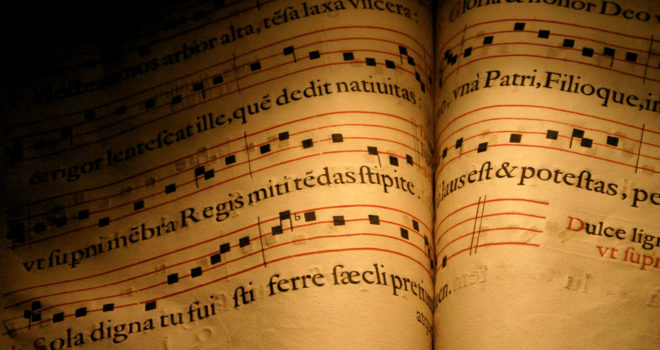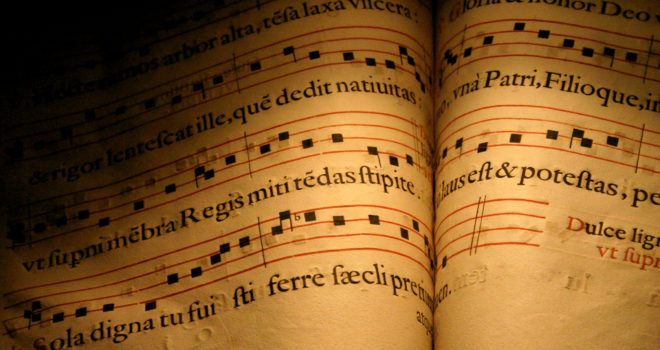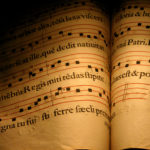Those who underestimate the efficacy of sound do so at their own peril. Filmmaking students are quickly introduced to this maxim: “What the ear hears is more important than what the eye sees.” This may come as a surprise. After all, isn’t a video primarily about what people see? But the truth remains: a pristine soundtrack is what “makes” any film. The balance, the musical ambience, the sound effects, the pacing, the volume—all must come together flawlessly, or all is lost. Since the 1960s, the Catholic Church has experienced a liturgical crisis. The insidious and shameful embrace of goofy, secular, cheesy Broadway tunes—which are sung during the Holy Mass—has (predictably) had a deleterious effect on faith. It is not necessary to earn a musicology doctorate to realize that much contemporary church music “sounds like a toothpaste commercial,” as Father Robert Skeris famously told Mother Angelica on EWTN.
Diagnosing the problem is easy. Fixing the problem? That’s another matter. The performance of music is perilous (although it sounds simple). If just one singer is off-key or misses a beat, the entire piece might come crashing down—and any director who’s stood in front of a congregation understands the piercing and unforgettable humiliation of such a “crash.” An experienced and skilled choirmaster can avoid horrible situations, but only with the correct repertoire and resources. Sophia Institute Press recently released a powerful resource: the Saint Jean de Brébeuf Hymnal. It is, quite simply, a “game changer.” (If only such a resource had been available when I was starting out as a choirmaster!)
Here are nine reasons the conscientious choirmaster should consider the Brébeuf Hymnal, which is unlike any other Catholic hymnal:
#1. Variety
Whether one directs music for the Ordinary Form or the Extraordinary Form, the full gamut of sacred music should be utilized: Plainsong, Guillaume de Machaut, Josquin des Prez, Cristóbal de Morales, Giovanni Palestrina, Francisco Guerrero, William Byrd, Gabriel Fauré, Francis Poulenc, Maurice Duruflé, Flor Peeters, Hermann Schroeder, Kevin Allen, and so forth. However, when it comes to volunteer choirs, one must include a healthy dose of “simple and bright” melodies; and that’s where the Brébeuf Hymnal comes in. The pew edition is about 900 pages long, and the tunes are—quite simply—the most splendid melodies ever composed … which is why these tunes have lasted for centuries!
#2. Does Not Mimic Protestants
Many Catholic hymnals billed as “traditional” are what might be called Leftovers. That is, the editors took a popular Protestant book—let’s say, the 1940 Episcopal Hymnal—and removed all the songs they didn’t care for (or which contained heresy). Then, whatever was leftover they label as a “Catholic” hymnal. The Saint Jean de Brébeuf Hymnal took a completely different approach. Its editors began with the Catholic patrimony of Latin hymnody and built upon that. The last time such a thing was done was eighty years ago for the New Westminster Hymnal.
3. Priests Can Rest Easy
A priest who wants good music at his parish can give his music director a copy of the Brébeuf Hymnal and confidently say: “Take this book. Use it. I know that everything contained in this hymnal is theologically sound. Moreover, I know that the tunes are dignified and excellent.”
4. The Best Patron
The greatest saints of North America were Father Isaac Jogues and Father Jean de Brébeuf. These fearless missionaries traveled to America—along with their companions—to evangelize the New World. The sufferings they underwent were nothing less than bone-chilling. Those who study the color plates (included in the pew edition) will understand the reasons Brébeuf was chosen as patron.
5. Words Matter
The Brébeuf Hymnal keeps the “original language” of the poets: Thee, Thine, Thou, and so forth. It also includes hymns by contemporary priests who write in today’s idiom (rather than a 19th-century idiom). Furthermore, the Brébeuf Hymnal editors did something marvelous; viz. they skillfully removed any word whose meaning has changed over the centuries if it has acquired a pejorative connotation.
6. True Catholic Tradition
In the Brébeuf pew edition, footnotes give the provenance of each tune and text, including a list of excellent Catholic hymnals which included them. In other words, this book does not invent a “new tradition” with songs no Catholic has ever sung. By the way, the theological footnotes and Bible references at the bottom of the page are superb.
7. Not Out Of Reach
The Brébeuf Hymnal uses a brilliant “shared melody” strategy, which is crucial in our present situation wherein most congregations (sadly) know precious few exemplary hymns. This strategy allows congregations to sing with gusto even on “once-per-year” feasts like: Ascension, Transfiguration, Baptism of the Lord, etc.
8. Hundreds of Rehearsal Videos
Free rehearsal videos (SATB) are being uploaded. Currently, there are about 900, with hundreds more forthcoming. This allows anyone with access to the internet to easily learn the SATB voice parts for each hymn. It’s bewildering that no other hymnal has created something similar.
9. Each Note For Each Lyric
For the first time in history, a “choral supplement” (1,192 pages) has been produced which places each and every verse underneath the SATB notes! The organ accompaniment volumes do likewise, as some organists must simultaneously serve as cantors.
As a choirmaster who directs about forty singers—all of whom are volunteers—I could not function without the Brébeuf Hymnal. This resource is the best (and most painless) way to restore authentic sacred music to our churches.
✠
Editor’s note: The Saint John de Brebeuf Pew Edition and Saint John de Brebeuf Choral Supplement are now available from Sophia Institute Press.










